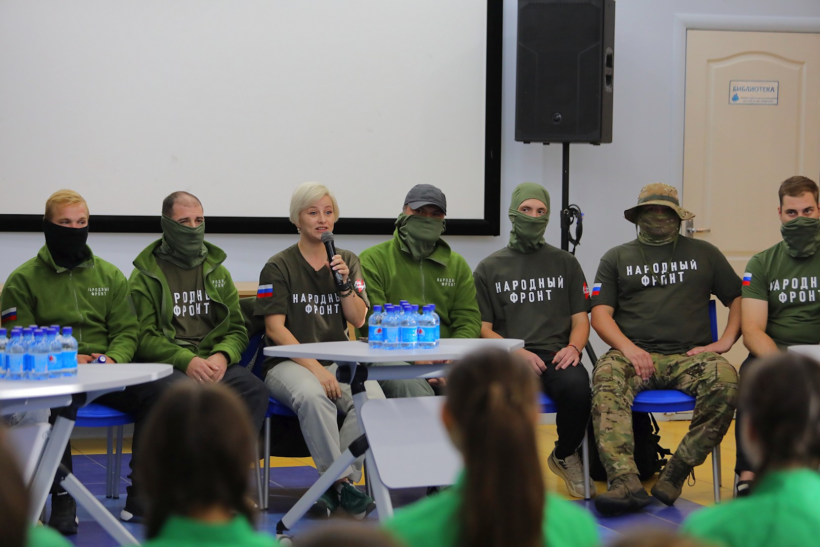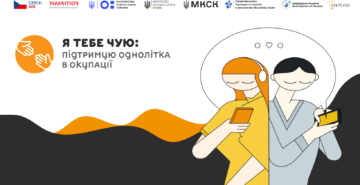

What does Russian education hide in the temporarily occupied Crimea?
Around 500,060 children live in the temporarily occupied territories of the Autonomous Republic of Crimea and the city of Sevastopol, of whom 285,000 attend schools run by the occupation authorities according to Russian standards. At the same time, any opportunities to study under the Ukrainian education system are being destroyed – according to the occupation authorities, only 197 children study in the Ukrainian language on the peninsula and in the 1st grade in a school with Russian as the language of instruction. In July this year, the occupation authorities announced the closure of two ‘pro-Ukrainian Islamic schools’ in the temporarily occupied city of Simferopol. Thus, formal and non-formal education in the occupation involves no alternative and compulsory attendance of children at propaganda, Russification and militaristic events that are held on a regular basis.
Formal education
Schools are taught using new textbooks, including history, which contain sections on ‘the coup d’état in Ukraine, the preconditions for the return of Crimea to the Russian Federation, the chronology of the Easter and the reactions of Western countries’, and children are taught to perceive distorted historical events in the interests of Russian state policy.
Photo of a detailed history textbook for grades 10-11, which is used in schools of the TOT of the Autonomous Republic of Crimea
Also, since September 1, 2024, children have been trained in firearms, medical training, and the control of unmanned aerial vehicles as part of the new subject “Fundamentals of Security and Defense of the Motherland” and consolidate their knowledge at the training ground. At the same time, so-called lessons of courage for children are conducted by Russian military personnel involved in the war against Ukraine. For example, on October 9, 2024, a meeting of the TOT of Simferopol was held at school 24 named after I.P. Klymenko in Simferopol. Simferopol, a meeting was held between members of the so-called IAG and 9th grade students. A similar event was held in Verkhorichenska school in Bakhchisarai district, where a Russian serviceman, Private Volodymyr Zaporozhetsev, spoke to children in grades 5-7 about his experience of participating in the so-called “special military operation” (SMO).
A photo of a student of school #24 of the TOT in Simferopol.Simferopol with a member of the so-called “SMO”, October 2024
Photo from a meeting of students of grades 5-7 with a member of the so-called SMO in Verkhorichenka school in Bakhchysarai district, October 2014
The general school curriculum is complemented by weekly line-ups with the national anthem and the display of the Russian Federation flag. These activities are followed by extracurricular lessons called “Talks about the Important”, which are also compulsory. Most of the topics of “Conversations about Important Things” are of a propagandistic nature: “The Day of Reunification of the Donetsk and Luhansk People’s Republics, Zaporizhzhia and Kherson Regions with the Russian Federation”, “Legends about Russia”, “Roads of Russia”, “Heroes of Our Time”, “Allies of Russia”, etc. The first “Conversation about Important Things” in the 2024-2025 school year was held personally by V. Putin, who approved the holding of such lessons for the youngest children, and they will soon be introduced in kindergartens.
Photo from the lesson “Conversations about Important Things” in the gymnasium №24 of the TOT of Sevastopol, held in October 2024
And from October 15 to November 15, 2024, the occupation authorities are holding an all-Russian action with a russification goal and a propaganda title “I am Russian” in the format of a digital lesson for 4th and 5th graders.
Informal education and recreation
Over the years of occupation of the Autonomous Republic of Crimea, it has become clear that formal education has become a tool for indoctrinating and Russifying Ukrainian children, but what about non-formal education? Do children have the opportunity to take a break from obsessive narratives?
Non-formal education is provided through children’s and youth movements that organize and conduct events, games, actions, competitions, etc. The most popular movements in the TOT of the AR of Crimea and Sevastopol are:
- “Youth Army” (the number of children involved reaches 28,000),
- “Movement of the First” (about 22,000 children),
- “Eagles of Russia” (involving about 38,000 children in grades 1-4),
- “Young Sevastopolites” (at least 4000 children involved).
Games that involve children outside of school hours are also not for children, but are actually aimed at preparing children for military service. In October of this year, the Patriot Park hosted a military-patriotic sports game, Defenders of the Fatherland, dedicated to the Day of Special Forces of the Russian Federation. The children competed in detecting and eliminating “mines”, disassembling and assembling AK-74 and AKM rifles, and took a military history quiz on tactical and technical characteristics and names of military equipment.
Photo from the Defenders of the Fatherland game, October 2024
After school hours, children from the age of 8 are offered a course on piloting unmanned aerial vehicles, as well as attend the field sports and training complex of maritime and initial military training “Defender of the Fatherland ” to learn diving and drone control.
Even seemingly ordinary vacations in children’s camps are used by the Russian occupation authorities as a platform for the Russification and militarization of children. For example, the stay of 500 children from the TOT of the Autonomous Republic of Crimea in the Dolphin camp during the “School of Young Atamans” shift was marked by militaristic activities: the All-Russian military sports game “Cossack Alert”, TRP and Spartakiad – competitions aimed at preparing pre-conscription “Cossack” youth for service in the Russian army – were held. The children were taught the skills of marksmanship, tactical medicine, flanking and saber skills.
Photo from the “Dolphin” camp, August 2024
In the camp “Field“, which is part of the Artek center, children were also taught how to assemble/disassemble assault rifles and shoot as part of the Order of Courage program, which is aimed at military and patriotic training of young people. Even the music festival in this camp included performances by children in military uniforms, performing patriotic songs from the repertoire of the band “Lyube”.
Photos from the events of the Camp “Field“, August 2024
In Artek, meetings with members of the so-called “military units” are held for children on a regular basis, during which Russian servicemen talk about their personal experiences, introduce children to weapons, and popularize military service. This summer, the participants of the shift “celebrated” the Russian flag day together with the military, probably from the Wagner PMC. In October, a meeting was organized for children with members of the so-called “military units” and the head of the regional executive committee of the Popular Front in Crimea, Alla Vertinskaya, aimed at glorifying Russian military personnel involved in the war against Ukraine.
Photo from a meeting between Artek members and fighters of the so-called “Svoboda”, October 2014
For more information about these and other Russian propaganda activities, as well as the geography of the removal of Ukrainian children from the TOT under the pretext of vacationing in camps, read the analytical report “Russian Propaganda Camps”: Where and Why Russia Takes Children from the Temporarily Occupied Territories
The above are just some examples of Russia’s deliberate process of eradicating the Ukrainian education system in the TOT, and integration into the Russian educational space is gaining momentum The whole process of education and leisure of young people in the TOT is openly militaristic, which is being improved based on the experience of the so-called “war of attacks” and is aimed at building a new consciousness of young people: in which Ukraine is perceived not as a homeland but as an enemy state, while Russia is a native country that must be defended



